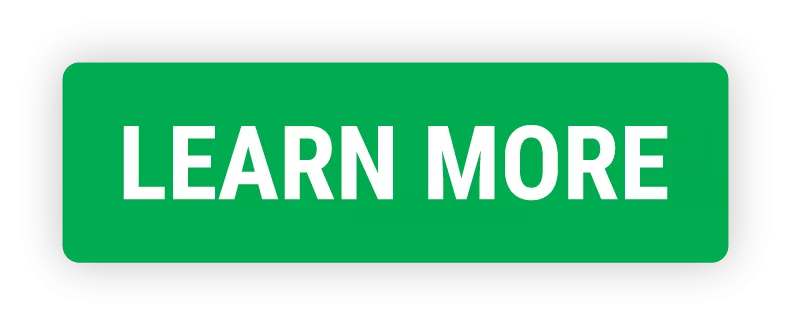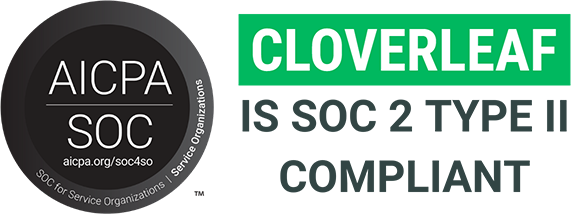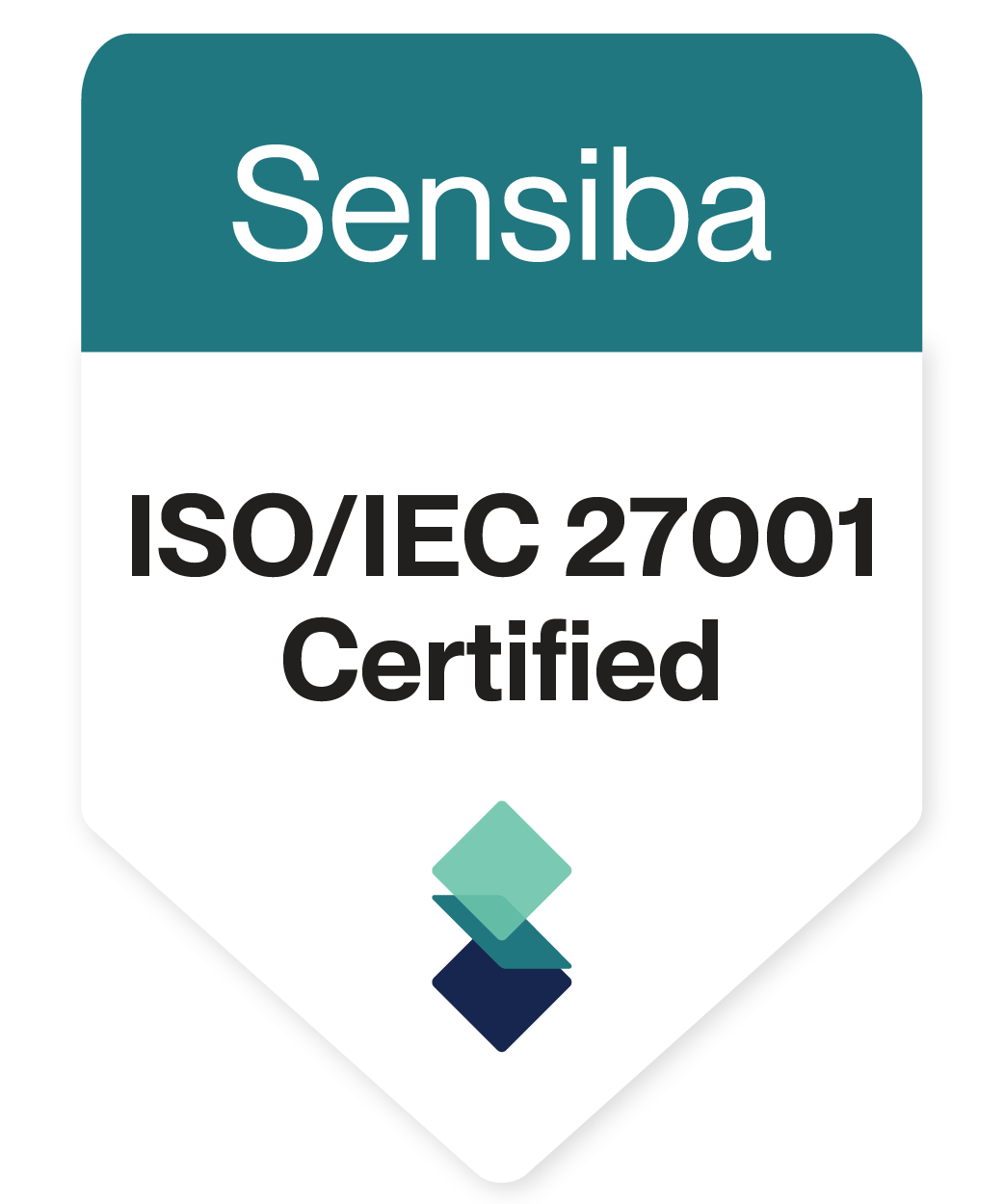Being an executive, leadership, or team coach is deeply rewarding when clients are engaged and committed to implementing the changes they seek. However, the actual coaching work happens between sessions—when clients must turn those conversations into action. Coaches often struggle to maintain engagement as client dynamics shift, with personality, leadership style, or external factors complicating the process.
Sustaining client engagement is complex, with dynamics shifting based on personality, leadership style, or external circumstances. Often, coaches simply hope the impact of a session sticks as clients navigate their day to day.
What if you could guarantee that engagement doesn’t erode but deepens? By embedding continuous coaching into daily workflows, you can create lasting behavior change and elevate your coaching engagements.
Coaches can inspire tangible behavior change by elevating engagements beyond surface-level interaction, helping clients achieve the lasting, valuable outcomes they came for. In this article, you’ll learn how to shift from hoping clients stay engaged to ensuring they do.

The Secret To Coaching Engagement That Inspires Real Behavior Change
One of the biggest hurdles in coaching is maintaining client engagement between sessions. It’s not just about attendance—it’s about ensuring clients continuously apply their learning in real-world scenarios. Clients may struggle to apply what they’ve learned in real-world scenarios without sustained engagement. The 2023 ICF Global Coaching Study revealed that 57% of coaching clients are sponsored by their organizations, meaning companies heavily invest in outcomes, not just participation.
Ready To Increase Your Coaching Impact?
Coaches who focus on authentic engagement see the greatest success. According to the same ICF study, coach practitioners have experienced a 60% increase in annual revenue since 2019, mainly due to their clients’ ongoing development. However, maintaining high engagement requires tools supporting client and organizational goals.
Coaches who experience growth understand that engagement is the cornerstone of success. However, there’s often confusion between engagement, satisfaction, and outcomes. Satisfaction may mean meeting a client’s basic expectations, but engagement is about deep, sustained participation that leads to measurable change. Engagement is the continuous, active participation that fuels results, while satisfaction is passive and tied to expectations. Outcomes are the measurable changes your client experiences.
To create this kind of sustainable engagement, you need the right tools. Tools like automated coaching help coaches strengthen the link between engagement and outcomes through data-driven insights, delivered precisely when and where your client needs them—right in their daily workflow. This way, engagement isn’t just a byproduct of a conversation but an ongoing, personalized interaction that keeps clients moving toward their goals.
Key Takeaway: Focus on tools that facilitate consistent, relevant engagement, ensuring clients stay invested in their journey toward measurable results.
Key Factors for Sustainable Coaching Engagement
Engagement in coaching is rooted in proven psychological and organizational theories. These key factors ensure clients stay committed and motivated:
- Autonomy, Mastery, Purpose: When clients feel empowered to make decisions, gain new skills, and see a clear sense of purpose, engagement flourishes.
- Psychological Safety: Create a space where clients feel secure enough to explore and take risks in their leadership journey.
- Continuous Growth: Align coaching with their daily workflows, ensuring that new behaviors are consistently reinforced.
Employees engaged in continuous learning within their daily workflow are 39% more productive and 23% more ready to take on new responsibilities. Enabling coaching in the daily routines of clients maximizes the effectiveness of coaching impact because it can directly align with their goals and work relationships.

Enhancing Coaching Engagement with Automated Support
True transformation in coaching doesn’t happen with surface-level conversations. To create long-term, meaningful change, coaches must dive deep into their client’s unique needs and goals—whether it’s leadership, team dynamics, or personal development. For executive and team coaching, combining challenging conversations with actionable insights that push clients toward growth is essential.
Often, clients leave a powerful coaching conversation only to struggle with implementing the insights they’ve gained when they’re back in their busy work environment. Without consistent follow-up or guidance, the momentum from a coaching session can quickly fade, and clients might revert to old habits, leading to slower progress and frustration for both coach and client.
To overcome this challenge, coaches need tools to provide support and reinforcement between sessions, helping clients stay on track even when not meeting face-to-face. This gap is where automated coaching comes in—a concept many coaches may not yet be familiar with but can transform the coaching experience.
What is Automated Coaching, and How Does It Work?
Automated coaching uses technology to deliver timely, personalized insights and tips to clients when you’re not present. Platforms like Cloverleaf send daily or weekly bite-sized coaching nudges to help clients use human skills based on their goals, team dynamics, or individual development needs.
This additional support allows clients to practice the principles you discussed in your sessions while receiving helpful nudges to initiate behavior change. Coaches can embed real-time, personalized learning into their clients’ everyday workflows to transform surface-level conversations into lasting, behavior-changing engagements.
How Automated Coaching Complements In-Person Coaching To Increase Engagement
Automated coaching isn’t meant to replace in-person coaching—it’s meant to enhance it. Think of it as an extension of your practice, designed to provide continuous support and reinforce your coaching principles when you’re not in the room. Consider that digital coaching tools can strengthen your client engagement:
- In The Moment Reinforcement: Instead of relying solely on weekly or monthly check-ins, clients receive immediate, actionable insights that align with the goals you’ve set during your sessions. This keeps the learning fresh and relevant.
- Building Accountability: Automated coaching provides structured, ongoing prompts that hold clients accountable. It’s like an assistant to your coaching to help them consistently apply what they’ve learned.
- Customizable to Client Needs: Platforms like Cloverleaf tailor the feedback based on real-time team dynamics or individual performance. This means the coaching tips are always personalized and relevant to what’s happening in your client’s work environment, leading to more engaged and empowered clients.
How to Integrate Automated Coaching into Your Practice
1. Start with Personality and Behavioral Assessments:
One of the most effective ways to ensure engagement is to clearly understand your client’s unique working style. Cloverleaf’s DISC, Enneagram, and other behavioral assessments provide coaches with a layered understanding of the client’s strengths, motivations, and growth areas.
Coaches can also save time and effort in preparing for coaching sessions by reviewing the dashboards before the session to design powerful questions. After reviewing these results, ask your client reflective questions: How do these insights align with your leadership style? Where do you see room for growth?
2. Set Specific and Action-Oriented Goals:
Engagement thrives when clients have clear, actionable goals. Coaches can partner with automated coaching tips to generate insights based on their clients’ daily tasks or team dynamics, using this data to set specific and attainable short-term and long-term goals.
For example, if a client struggles with delegation, use Cloverleaf to spark discussions about ideas for improving their delegation efforts over time—access tangible ideas relevant to the individual for tapping into their strengths and collaborating with their teammates.
3. Embed Continuous Feedback Loops:
Engagement doesn’t happen overnight, it requires ongoing attention. Integrate Cloverleaf’s automated coaching into daily or weekly touchpoints, offering leaders bite-sized tips and feedback on their interactions and meetings.
For instance, weekly bite-sized tips tailored to your client’s specific challenges can help them focus on their goals. Cloverleaf’s Reflections feature prompts clients to review their actions between sessions to bridge the gap between coaching conversations so that learning is continuously applied.

Rethinking Customization: Coaching for Maximum Impact
Addressing the increasingly complex challenges today’s leaders face is also a complicated task for coaches. While personalization has always been a cornerstone of executive coaching, it’s time to push beyond the idea that customization begins and ends with in-person sessions.
Can You Coach Without Being Present?
What if you could guide your clients when they aren’t in the room? Cloverleaf’s personalized insights make it possible. Imagine your client encountering a challenging team dynamic at work. Traditionally, they’d wait until your next session to discuss it. But with automated coaching, you can deliver real-time, tailored feedback to help them navigate the issue at the moment it occurs.
It’s not just about adjusting your approach based on personality data during in-person sessions. Automated coaching tools extend that customization, bringing behavioral insights to life every day. For example, Cloverleaf can send regular prompts that help your clients become more aware of their communication style, team dynamics, and real-time decision-making processes. This capability keeps your coaching alive for day-to-day micro-moments of growth rather than relying solely on high-level, scheduled meetings.
Initiating Change in Leadership Coaching & Development
By aligning on demand insights with the unique needs of your clients, you create a continuous coaching experience that challenges traditional models. Leaders no longer have to rely solely on what’s discussed during the session—they can receive real-time, automated coaching that nudges them to act in alignment with their goals at critical moments.
Key Takeaways for Coaches
- Challenge traditional coaching models by integrating real-time, automated feedback into your client’s workflow.
- Leverage tools like Cloverleaf to extend your influence beyond the session, helping clients apply coaching principles in the moment.
- Move beyond one-size-fits-all coaching by offering continuous, timely personalization. This will ensure that your clients are engaged with their development every day, not just during sessions.
Measuring Coaching Success Must Go Beyond Satisfaction Tools
Many coaches rely on post-session satisfaction surveys or client feedback forms to measure the success of their engagements. However, surface-level metrics like these only provide a snapshot of client perception and don’t capture real behavioral change or the depth of engagement necessary for sustained growth. The challenge is that these measures often reflect how a client feels in the moment, not how effectively they are applying coaching insights in their day-to-day actions.

Supplement Satisfaction Scores With Tracking Real-World Engagement
Post-session surveys may give you feedback on how clients feel about a session, but they fall short when it comes to measuring long-term change. To accurately understand how engaged your clients are, you need to track whether they consistently apply the insights from coaching in their daily work. Tools like Cloverleaf’s Reflections allow you to review the frequency and depth of client engagement between sessions, to track actions, goals, or the frequency of using daily tips.
Cloverleaf makes it easy to take a data-driven approach to measuring engagement. With its built-in insights dashboard, coaches can track progress, see which coaching tips resonate most with clients, and identify trends in team dynamics through tools like the Thinking Styles Comparison. Integrating this data into your coaching strategy allows you to continuously refine your approach, ensuring your clients are engaged and seeing measurable performance improvements over time.
How Coaches Use Cloverleaf To Provide Even More Value to the Coaching Experience
Working with a hospitality manager who faced challenges connecting with a team member who was recently caught up in some conflict with multiple team members, I decided to use Cloverleaf’s Thinking Styles Comparison feature. Instead of getting caught up in the details and drama of the situation, this tool helped us focus on understanding the unique communication styles at play. What happened next was remarkable. By tailoring coaching questions to the insights provided, the client quickly recognized how different their team member’s approach was. With this newfound clarity, we crafted a personalized communication strategy that transformed their relationship completely. Within just weeks, frustration evolved into genuine collaboration—because the plan was built around who they are as individuals, not just generic advice. – Cloverleaf Coach Partner
Client engagement between sessions is crucial but should be client-driven. I believe their insights should guide their actions. To support this, I provide relevant exercises or articles that align with their goals, along with offering check-ins via email or short 15-minute calls.
Cloverleaf’s weekly automated coaching emails are invaluable—my clients love them! They are always spot-on, and I encourage micro-goals based on the insights. Paired with Cloverleaf’s Reflections feature, clients track their growth through a “digital journal” that aligns with the insights gained during our 1:1 sessions. Recently, I led two leadership workshops focused on creating mission and vision statements. Cloverleaf was instrumental in aligning the team, energizing them individually and collectively, and clarifying communication and leadership direction. It helped the team create clear, passionate mission statements, making the process fast, effective, and enjoyable. – Cloverleaf Coach Partner
Successful coaching doesn’t stop with insights shared during a session—it extends into how clients engage with those insights in their daily work. Cloverleaf’s tools, particularly the Thinking Styles Comparison and automated weekly coaching tips, empower coaches to provide personalized, actionable feedback that drives ongoing engagement beyond the traditional coaching framework.
A Central Emerging Trend in Coaching Engagement: Technology Driven Support
As the coaching industry rapidly evolves, the increasing reliance on technology-driven micro coaching solutions is one of the most transformative trends. Tools like Automated Coaching™ are transforming how insights are delivered to clients, providing real-time, personalized guidance that seamlessly integrates into their daily workflows. Unlike traditional coaching models that rely solely on scheduled sessions, these technological solutions offer continuous, bite-sized coaching at the precise moment it’s needed most.
This shift toward coaching in the flow of work is essential for meeting the demands of modern workplaces, where quick decision-making and agility are critical. By delivering context-specific insights directly to clients during their workday, automated coaching platforms help foster immediate application and behavior change, leading to more impactful results.
Additionally, the demand for data-driven personalization is growing, as clients expect coaching that is finely tuned to their unique strengths, challenges, and professional contexts. By leveraging AI and data analytics, coaches can now provide tailored experiences that reflect the individual needs of each client. This level of personalization not only enhances engagement but also improves outcomes by ensuring that clients receive coaching that is relevant, timely, and deeply aligned with their specific goals.
For coaches to stay relevant and effective, embracing these technology-driven solutions is rarely optional—it’s essential. The ability to offer clients on demand support and data-driven personalization will be a key differentiator in an industry where agility and ongoing engagement are critical. As clients continue to expect coaching that is tailored, immediate, and seamlessly integrated into their work lives, those who adopt these trends will be better positioned to deliver results that resonate.
How To Adapt Your Coaching Engagement Strategy
Client needs are evolving, and the expectations for what a coaching relationship should deliver have shifted dramatically. As a coach, you may feel the pressure to provide immediate, actionable insights while still maintaining the personal touch that makes coaching so effective.
How do you balance these demands? By embracing scalable, technology-driven solutions that don’t just supplement your coaching sessions but integrate into the daily workflow of your clients. Tools like automated coaching offer the ability to deliver real-time feedback and insights when they’re needed most, allowing you to be there for your client, even when you’re not in the room.
But technology alone isn’t enough. As more clients expect coaching tailored to their unique work environments, your coaching model must stay flexible. This means offering dynamic coaching sessions that can shift and adapt based on behavioral trends and client needs. Continually learning and integrating tools that enhance human connection rather than detract from it will set you apart. Coaches who adopt this mindset will thrive in the ever-changing landscape of professional development.
Keeping Clients Engaged Between Meetings
Your coaching work is only as effective as the engagement you maintain between sessions. One of the biggest challenges coaches face is helping clients maintain momentum once a session ends. How often have you finished a powerful conversation with a client only to worry that the insights gained will fade away in the daily rush of work?
At its core, coaching is about guiding clients toward their full potential—and sustained engagement is key to making that happen. When clients stay engaged, they’re not just experiencing fleeting moments of inspiration; they’re making long-term changes that impact their work, relationships, and personal growth.
To make your coaching effective, you need the right mix of human connection and real-time tools to ensure your clients are learning, reflecting, and applying insights in a way that creates real change. It’s not about replacing the human element of coaching—it’s about enhancing it. The future of coaching lies in the ability to deliver deeply personalized experiences that resonate well beyond your sessions, driving results that last.
The workplace is transforming at a pace that rivals even the most imaginative sci-fi epic (cue your internal Star Wars music), and with it, managers’ roles are becoming far more impactful. Gone are the days when management was about supervising tasks and enforcing rules.
Today’s landscape demands a shift towards a culture where every team member is “all-in”—empowered, engaged, and fully committed. This kind of environment isn’t just a nice-to-have; it’s a necessity for organizations that want to thrive in an increasingly competitive and unpredictable world.
But as talent development and organizational leaders, how do you lead this transformation? How do you move from traditional management practices to a coaching-focused leadership style that truly energizes your workforce? You know the importance of development, but the challenge lies in making it actionable and deeply ingrained in your culture.
In this article, we’ll break down the steps necessary to cultivate a coaching culture that emphasizes creativity, collaboration, and continuous learning. More than ever, your organization needs leaders who can coach, not just manage.
Transitioning to this new model can feel overwhelming, but it’s also a path filled with opportunities to unlock your teams’ full potential. We’ll explore what it takes to make this shift, including practical strategies to help you embed a coaching culture that meets and exceeds the aspirations of your people and your organization.

Leading Beyond Management: The New Case For A Coaching Approach
Coaching as a leadership culture isn’t just the latest trend—it’s a strategic evolution that forward-thinking companies have been adopting for decades. In industries where innovation drives success, like SaaS, startups, and scaleups, this coaching approach has surged in the last 10-15 years. Why? Because these companies understand that unleashing creativity, engagement, and growth within teams isn’t just an added benefit—it’s a non-negotiable for innovation and, let’s face it, profitability.
Top-down, command-and-control management styles do more than frustrate employees—they actively suppress high-potential talent and inquisitive minds. When employees are reduced to merely executing orders, their potential is not just capped; their engagement plummets. But the fallout isn’t limited to employees. Managers, under the constant pressure to make every decision, end up trapped in slow problem-solving cycles, leading to a lack of resilience across the board.
In a world where rapid change is the only certainty, these dynamics can cripple an organization’s ability to adapt and innovate. Transitioning to a coaching culture doesn’t just address these issues—it transforms them. By empowering employees to take ownership, encouraging critical thinking, and shifting managers from directors to guides, organizations cultivate a resilient, agile, and engaged workforce ready to meet today’s fast-evolving challenges head-on.
Ready To Create Behavior Change In Your Team?

Laying the Foundation for a Coaching Culture: Trust, Empowerment, and Transformation
Shifting from a traditional management model to a coaching culture is not just about tweaking a few practices but a deep, organization-wide transformation. Talent Development leaders already understand the need for this shift—they’re well aware of the benefits that a coaching culture brings. The real challenge lies in executing this transformation effectively within your organization. The real question is how to create the conditions for a coaching culture to thrive effectively.
Below, we’ll explore how trust, empowerment, and mindset transformation are the cornerstones of this cultural change. These elements aren’t just abstract concepts; they are actionable strategies you can implement as a leader to create a thriving coaching environment.
Whether your goal is to bridge trust across diverse teams, empower managers to step beyond micromanagement or reshape mindsets for genuine, lasting change, the following strategies aren’t just about theory—they’re about igniting real transformation. These are not just tools to add to your toolkit; they are catalysts for the cultural shift that drives innovation, resilience, and collective success in your organization.
Trust as the Cornerstone
You already know that trust is foundational to any coaching relationship, but how do you actively cultivate it across diverse teams? It’s more than just encouraging open communication; it’s about creating consistent, trust-building behaviors at every level of the organization. Leaders must model vulnerability, admit mistakes, and encourage others to do the same. Trust grows when team members feel psychologically safe enough to take risks and express ideas without fear of judgment or retribution.
Empowerment Through Delegation
Empowerment is a key to unlocking your team’s potential. But how do you ensure that empowerment isn’t just lip service? It starts with delegating meaningful tasks, not just busy work. Talent development leaders need to challenge their managers to step out of the role of the “heroic problem-solver” and instead become facilitators of their teams’ growth. Empowerment means giving employees the autonomy to make decisions and the support to navigate their challenges, knowing that they have the tools and backing to succeed.
Transforming Mindsets for Lasting Change
The shift to a coaching culture requires more than a surface-level change in behavior; it’s about transforming the underlying mindsets that drive those behaviors. This means moving away from a focus on correcting mistakes to one of continuous learning and development. Leaders must be equipped to coach not just for performance but for growth—helping employees not only meet current objectives but also develop the skills and mindsets they’ll need in the future.

Empower Your Organization For A Seamless Transition into a Coaching Culture
Transitioning from traditional management to a coaching culture is a significant shift that requires intention, strategy, and patience. It’s not about flipping a switch but about taking deliberate steps to create lasting change. The following steps will provide you with the tools and strategies needed to confidently embed a coaching mindset into your organization’s DNA, ensuring that this cultural transformation is as smooth as it is impactful.
1. Equip Your Leaders With Coaching Skills
Creating a coaching culture starts with empowering your leaders to become coaches. Think of it like training a team for a big game—you wouldn’t send them in without the right skills and strategies. It’s not enough for leaders to have management experience; they need specific coaching skills that align with your organization’s goals and culture.
To ensure this transformation happens at scale, consider the broader context in which your leaders operate. Training shouldn’t just be about isolated sessions but building a unified coaching experience that every leader can understand and apply consistently across the organization. This is where a common language becomes vital. When all leaders are trained with the same resources and tools, it creates alignment and ensures that coaching conversations are effective, no matter who is leading them.
Even seasoned leaders can benefit from focused coaching training. It’s about more than just a refresher; it’s about ensuring everyone is on the same page and ready to support their teams in a way that encourages growth and innovation.
Start by identifying the key coaching skills that are most relevant to your organization. These could range from active listening and effective questioning to providing constructive feedback. Once you clearly understand what’s needed, offer tailored training sessions that are practical and immediately applicable.
A quick win? Start small.
Incorporate coaching opportunities into your existing meetings or one-on-ones. For example, shift from telling employees what to do to asking them how they think a problem should be solved. This subtle change can start to build the coaching mindset without overwhelming your leaders or team.
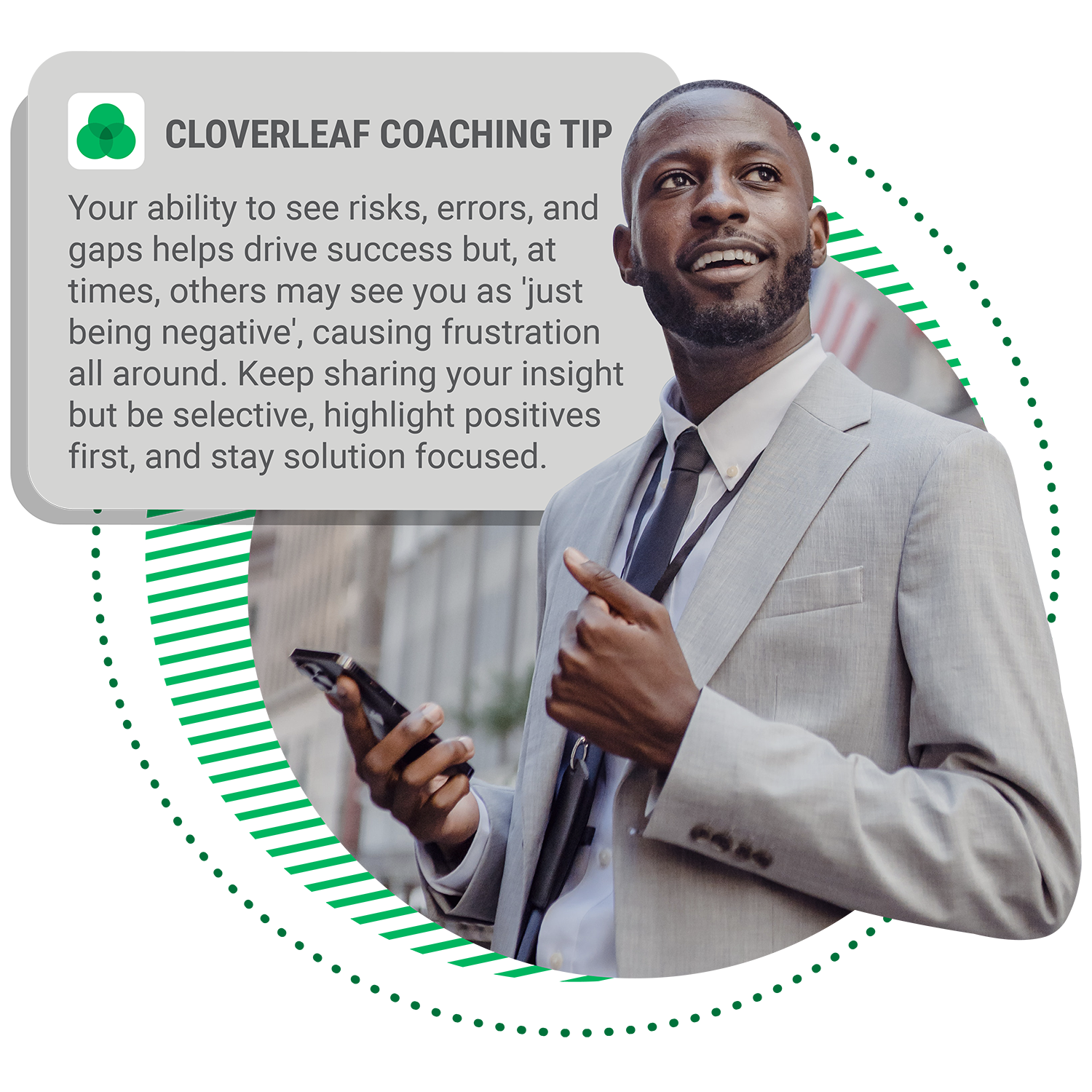
2. Leveraging Technology to Make Coaching Sticky
Coaching doesn’t have to be overwhelming, especially when you have the right technology in your corner. The real transformation begins when you move away from traditional, infrequent performance reviews to more dynamic, ongoing coaching conversations. Tools like Cloverleaf make integrating coaching into your daily routines seamless and impactful.
Think of these tools as your real-time coaching assistant. With instant access to insights into team dynamics and individual strengths, you can tailor your coaching approach on the fly. Imagine having a continuously updated playbook that helps you adjust strategies to fit the unique needs of each team member. Cloverleaf’s real-time coaching tips and visual dashboards are designed to make this easy, providing a clear view of where your team is excelling and where they may need extra support.
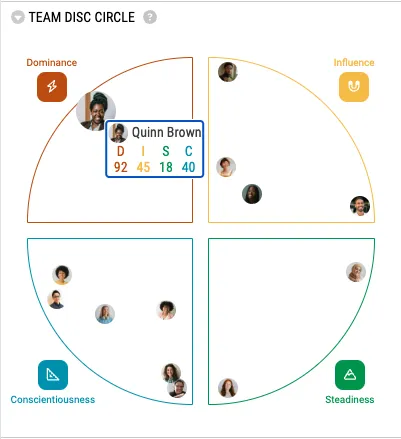
The beauty of leveraging technology is that you don’t need to upend your entire process overnight. Start small by incorporating these tools into your existing workflows. For instance, before your next one-on-one, use a tool like automated coaching to review personalized coaching tips that are contextual based on the individual’s strengths and communication style. This approach not only enhances the effectiveness of your coaching but also demonstrates to your team that you’re deeply invested in their personal and professional growth.
How I Used Cloverleaf To Shift Leaders To A Coaching Approach
In a recent collaboration with one of my clients, we set out to transform their leadership culture by integrating continuous, personalized feedback into their daily routines. The goal was to move away from the traditional once-a-year performance reviews and instead create an environment where coaching conversations happened regularly and naturally.
We introduced Cloverleaf into their daily workflow to make this shift manageable and sustainable. Rather than overwhelming the team with a massive cultural overhaul, we implemented small, iterative changes that gradually embedded a coaching mindset into everyday operations.
Cloverleaf’s visual dashboard quickly became a game-changer. Leaders were able to pinpoint team strengths, identify skill gaps, and recognize opportunities for delegating tasks more effectively. The daily tips feature, integrated into Slack, prepared employees for their interactions, inspiring a coaching mindset across the entire organization. This approach allowed leaders to adapt their leadership style progressively, reinforcing the coaching culture without disrupting the team’s existing processes.
By equipping the team with these tools, we didn’t just initiate a shift; we laid the groundwork for a robust, all-in coaching culture that’s poised for long-term success.
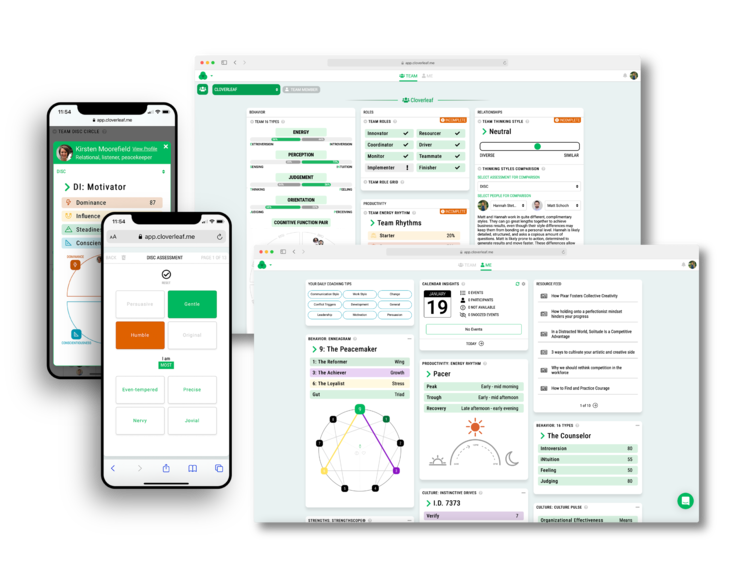
3. Activate the Coaching Mindset
After equipping your leaders with the right training and tools, the challenge shifts to integrating coaching into the daily operations of your organization. This integration facilitates a mindset where coaching becomes a natural, ongoing part of how your teams function and grow together.
Start by establishing regular feedback loops, ranging from quick, informal check-ins to more structured one-on-one sessions. The goal is to normalize feedback as a routine part of your team’s day-to-day interactions, making it easier for team members to reflect, learn, and grow continuously.
Promoting autonomy within your teams is another crucial element. Empower your employees by giving them the freedom to take ownership of their roles and the support they need to navigate challenges. Recognize and celebrate those who exemplify the coaching culture you aim to create. Highlighting these coaching moments reinforces the desired behavior and motivates others to adopt similar practices.
When feedback, autonomy, and recognition are woven into the fabric of your daily operations, the coaching mindset can truly take root. This is how you cultivate an all-in culture, where every team member is engaged, empowered, and contributing to the organization’s success.

How To Ensure Your Coaching Culture Takes Root
Transforming your organization’s culture is no small feat. It’s easy to kick things off enthusiastically—through workshops, events, and all the bells and whistles—but what happens after the initial excitement fades? The true test of a successful coaching culture lies in its longevity and the tangible benefits it brings to your organization over time. – Marnie Robbins, Founder of Vibe People Studio
To ensure your coaching culture sticks, tracking its impact continuously is essential. As the saying goes, “What gets measured gets managed.” Here’s how you can systematically evaluate your culture’s evolution:
- Share Surveys: Conduct surveys regularly to gauge employee sentiment and engagement. These surveys will provide quantitative data on how your team perceives the coaching culture and whether it is creating a positive work environment. Are your employees feeling more empowered? Are they more engaged?
- Gather Feedback: Never underestimate the power of direct feedback. Creating open channels for dialogue allows employees to share their real experiences with the coaching initiatives. This qualitative insight can uncover underlying issues or highlight successes that raw data might miss. It also signals to your team that their voices are heard and valued.
- Conduct Listening Tours: Take a hands-on approach by organizing listening tours where leaders engage with employees across different levels and departments. This method helps bridge gaps between leadership intentions and employee experiences, ensuring that the coaching culture resonates throughout the organization.
- Measure Performance Metrics: Track key performance indicators (KPIs) such as productivity, innovation, and team collaboration. For instance, monitor how customer success scores correlate with employee sentiment. These metrics provide concrete evidence of how the coaching culture influences overall performance, linking cultural shifts directly to business outcomes.
Consistently reviewing these metrics will help you identify where your coaching culture is thriving and where adjustments may be needed. This ongoing assessment enables you to fine-tune your approach, ensuring that your coaching culture aligns with your organizational goals and drives genuine, sustainable success for your team.
Coaching: The Strategic Investment In Your Organizations Future
Adopting a coaching approach isn’t just about enhancing your people initiatives—though that’s a powerful outcome. It’s about aligning leadership strategies with the evolving demands of today’s business landscape. Companies that successfully integrate a coaching culture aren’t just keeping up with the times; they’re positioning themselves to lead, innovate, and thrive. When every team member is engaged, empowered, and contributes to a shared vision, the organization moves forward with a unified strength.
The journey toward a coaching-focused leadership model is more than just a shift in management style—it’s a strategic investment in your organization’s future. By investing in a culture where coaching is the norm, you unlock the full potential of your teams, paving the way for sustained success and innovation.
Do you want to see the impact of automated coaching for yourself? Schedule a Cloverleaf demo today to learn more about scaling the impact of your team coaching program.
Today’s leaders are navigating an increasingly complex challenge: building cohesive, high-performing teams in a hybrid and remote work environment. Misaligned goals, fragmented communication, and inconsistent collaboration often lead to frustration, reduced productivity, and disengaged teams. As coaches and consultants, you’re frequently called in to resolve these issues, yet scaling traditional 1-1 coaching approaches to address the intricate dynamics of modern teams can feel like an uphill battle.
These challenges demand a more holistic approach—one that goes beyond individual coaching to address the team as a dynamic whole. Team coaching offers this solution by providing a structured, scalable method to unify diverse teams, drive sustained behavioral change, and align collective efforts toward shared goals. Rather than patching up problems as they arise, team coaching equips teams with the tools and strategies to anticipate and overcome these hurdles together.
In this article, we’ll guide you through a practical, step-by-step process for designing and implementing a team coaching program that meets these needs. From gathering actionable insights and setting clear objectives to structuring impactful sessions and tracking progress, you’ll discover how to create a program that addresses immediate concerns and builds a foundation for long-term success.

First, Does Your Approach To Team Coaching Need Reimagining?
Leaders and organizations often find themselves confined by the traditional limits of 1-1 coaching: high costs, restricted access, and a narrow focus on individual development that fails to address the broader team dynamics. These limitations can leave critical team issues unaddressed, leading to misalignment, communication breakdowns, and stalled progress.
Let’s be honest: Traditional coaching methods are great, but they’re often not enough. You already know this. The real challenge—and opportunity—lies in scaling coaching beyond the individual to the entire team. Modern, tech-savvy team coaching breaks free from the limitations of conventional approaches. It’s about more than just keeping everyone on the same page—it’s about rewriting the entire playbook.
Team coaching promotes continuous development across every level, making sure everyone—from the newest hire to the most seasoned executive—grows in sync. It’s not just about ticking the boxes on individual improvement; it’s about embedding those skills into the team’s DNA so they’re prepared to tackle challenges head-on and drive real, lasting success.
Imagine the shift when team coaching realigns communication and goals. Suddenly, what once felt like insurmountable roadblocks become stepping stones to growth. With each voice contributing, new strategies emerge—creating a unified team that’s not just connected, but resilient and ready to tackle challenges head-on.

How To Create A High Impact Team Coaching Program
Designing an effective team coaching program requires more than just a plan—it demands a strategic approach that challenges the way you think about team development. As coaches, it’s easy to rely on what we know works for individuals, but scaling those practices to a team level? That’s where the real work begins.
This guide isn’t just about following a static approach; it’s about using a framework to create a customized program that is unique to the team. Gathering insights isn’t just about collecting data—it’s about actively digging deep to uncover what truly drives each team you coach. Setting goals shouldn’t feel routine—it should feel like crafting a vision that challenges the status quo of every culture. Structured sessions are not about following a script but about creating an experience that resonates with those participating.
Whether you’re reassessing how you track progress or reimagining how you engage with your team, this guide will equip you with the tools to create a program that’s not just effective but unique.
Step 1: Collect Anonymous Team Data
Before diving into the coaching program, starting with a deep understanding of your team’s current dynamics is crucial. Gathering honest, unfiltered feedback is essential, as it reveals surface-level issues and the underlying challenges that may be holding the team back. Using anonymous surveys or assessments, you can create a safe space for team members to voice their thoughts and concerns without fear of judgment, ensuring the data you collect is candid and actionable.
Let’s think beyond the usual data-gathering routine: this step is about truly hearing the team’s collective voice. The goal is to uncover the strengths that can be leveraged and the areas for growth that need addressing, setting the stage for a coaching program that is not only relevant but transformative.
Tools: Start by designing a brief yet targeted survey that digs into critical areas of team dynamics. Consider questions that provoke deeper reflection, such as:
- How effectively does our team communicate? (Scale of 1-10)
- What communication challenges have you noticed within the team?
- Do you feel that you can openly share your thoughts and ideas with the team without fear of judgment? (Yes/No)
- If no, what are the barriers to building trust within the team?
- Do you feel that everyone on the team understands their role and responsibilities? (Yes/No)
- How well do individual strengths align with team goals?
- Do you feel your skills and strengths are being fully utilized in your current role? (Yes/No)
- What additional strengths do you believe the team should leverage more?
- Do you have the tools and resources you need to do your job effectively? (Yes/No)
- If not, what resources are missing?
- Are there areas where the team could benefit from further development or training? (Yes/No)
- What specific skills or knowledge areas would you like to see the team develop?
- How effective is the team’s decision-making process? (Scale of 1-10)
- What could improve the way we make decisions as a team?
Using this data, determine focus areas to discuss in session one based on date, such as Team communication, conflict resolution, and collaboration effectiveness.
Outcome: The anonymized data collected through this process will highlight key areas for development and growth, serving as the foundation for a customized, impactful team coaching program.
Step 2: Define Clear Objectives and Outcomes in Session 1
With the insights gathered from your data, it’s time to translate those findings into actionable objectives. This step is crucial—it’s where your team coaching program begins to take shape, and involving the entire team in this process is essential. After all, when objectives are co-created, they’re more likely to resonate and drive meaningful change.
But here’s the challenge: Don’t settle for vague goals. Each objective should be laser-focused, measurable, and directly tied to your collected data. This is your opportunity to move from insights to impact. For example:
- Objective: Enhance team communication and reduce misunderstandings.
- Expected Outcome: A 30% decrease in communication-related conflicts within three months.
This level of specificity not only aligns your sessions with the team’s needs but also provides clear benchmarks for measuring progress. Remember, your objectives are the roadmap for your program—make sure they lead somewhere transformative.
Step 3: Structure the Team Coaching Sessions
Now that you’ve set clear objectives, the next step is to design sessions that are aligned with these goals and engaging and impactful. This isn’t about checking off a list of activities but crafting experiences that drive real change.
Each session should build on the last, creating a cohesive journey that moves the team closer to the desired outcomes. Here’s a structure to consider:
- Session Topics: Trust-building exercises, effective communication strategies, collaborative problem-solving.
- Activities: Group discussions, role-playing scenarios, peer feedback sessions.
- Expected Outcomes: Improved trust, clearer communication, and enhanced problem-solving skills.
The key here is interaction. Sessions should be dynamic and responsive, encouraging active participation and ensuring that every member feels engaged and valued. By structuring your sessions this way, you’ll not only make the content more memorable but also more actionable, leading to tangible improvements in team dynamics.
Step 4: Create Benchmarks of Success
Once your program is underway, it’s essential to establish benchmarks that will help you measure success and keep the program on track. These benchmarks shouldn’t be arbitrary—they need to be tightly aligned with your objectives and flexible enough to allow for adjustments as the program evolves.
But here’s the key: Benchmarks are not just milestones but indicators of whether the coaching program is making a real difference. They should reflect both the immediate and long-term impact on the team’s dynamics and performance. For example:
- Short-Term Benchmarks: Increased participation in discussions and early signs of improved communication.
- Mid-Term Benchmarks: Reduction in team conflicts and more effective collaboration on projects.
- Long-Term Benchmarks: Achieving the overall objectives and sustained improvement in team dynamics.
Regularly reviewing these benchmarks isn’t just about tracking progress—it’s about ensuring the program remains responsive to the team’s needs. By staying vigilant and adaptive, you can make informed adjustments that keep the program effective and relevant, driving continuous improvement.

Step 5: Amplify Your Coaching Program with Automated Coaching Tools
To truly elevate the impact of your team coaching program, integrating advanced tools like automated coaching can significantly extend your reach and effectiveness. This isn’t about substituting the human touch that is essential in coaching—it’s about reinforcing your efforts with real-time, personalized insights that are seamlessly integrated into your team’s daily workflow.
See How To Transform Assessments Into More Revenue For You
As a coach, your expertise and intuition are invaluable. However, there’s a limit to how much individualized support you can provide, particularly in larger teams or organizations. Automated coaching tools, such as Cloverleaf’s Automated Coaching™, empower you to deliver consistent, tailored coaching insights directly to your team members in real time. These tools can be especially powerful in several key areas:
- Real-Time Data-Driven Insights: Automated coaching tools analyze team dynamics and individual behaviors, offering a depth of understanding that goes beyond surface-level observations. Imagine having access to data that illuminates not just what’s happening within your team but why it’s happening—allowing you to proactively address issues before they escalate.
- Personalized Coaching Tips: Ensuring your guidance resonates with each team member can be challenging. Automated coaching delivers personalized tips and strategies that align with each team member’s unique strengths, communication styles, and areas for growth, ensuring that your coaching is relevant and deeply impactful.
- Continuous Development: Coaching sessions are powerful, but their impact can diminish over time if not reinforced. Automated coaching tools provide ongoing support and reminders, embedding the lessons from your sessions into the team’s daily interactions. This ensures that progress is sustained and team members continue to grow long after the coaching session ends.
Perhaps think of it like adding a skilled assistant to your coaching team—one who works around the clock, providing personalized guidance to each team member based on real-time data. This assistant never tires, continuously reinforcing the specific insights you’ve shared and ensuring that every coaching session’s lessons are embedded into the team’s daily workflow.
Just as a skilled assistant amplifies your effectiveness by handling detailed follow-ups and personalized support, automated coaching tools extend your reach, allowing your influence to be felt consistently, even when you’re not physically present. It’s not about replacing your expertise but about enhancing it—making sure that the impact of your coaching is sustained and that every team member receives the ongoing support they need to grow and succeed.
Implementing Team Coaching Programs With Ease
Turning a well-designed coaching program into reality takes more than just planning—it requires confidence, adaptability, and a deep understanding of your team’s unique dynamics. Bringing your team coaching program to life is where your expertise truly shines.

Implementation is where theory meets practice, and it’s often the stage where many coaching programs stumble. But with the right strategies in place, you can lead confidently, ensuring that your team coaching program takes root and thrives. This guide is here to support you through each critical phase of implementation, from keeping participants engaged to leveraging technology that reinforces your coaching efforts long after the sessions end.
You can move forward with the assurance that you have the tools, insights, and strategies to turn your team coaching vision into a powerful reality.
1. Use Best Practices for Engaging and Motivating Participants
Effective team coaching is about more than just delivering insights—it’s about making those insights resonate with your team members and motivating them to actively engage in the coaching process. The challenge lies in ensuring that every participant feels connected to the content, sees its relevance to their own experience, and is inspired to apply it in their daily work.
A. Tailor Coaching to Individual Needs:
Every participant has unique strengths, challenges, and perspectives. Generic advice won’t cut it. Tailor your coaching to each individual by leveraging micro coaching moments. Tools that can deliver personalized insights that align with each participant’s specific context help make the coaching more relevant and impactful. When team members see that the coaching directly applies to their work and personal growth, they’re more likely to engage deeply and take ownership of their development.
B. Encourage Active Participation:
Engagement isn’t just about showing up—it’s about actively participating. Encourage methods that require involvement through real-time feedback, discussions, or interactive exercises. This dynamic approach keeps participants interested and strengthens a deeper understanding of the material. When team members are actively involved, they move from passive recipients to active learners, which is crucial for lasting change.
C. Maintain Momentum with Frequent Touchpoints:
Keeping participants engaged over time is key to ensuring the long-term success of your coaching program. Frequent touchpoints, such as brief, consistent coaching nudges, can help maintain momentum and reinforce learning. These nudges, integrated seamlessly into the team’s daily workflow, serve as reminders and motivators, ensuring that the coaching content remains top-of-mind. (And yes, Cloverleaf can automate these nudges for you!)
2. Unify The Team Coaching Experiences
One of the greatest challenges in a team coaching environment is ensuring that every participant not only understands the material but also applies it in a way that contributes to a unified team dynamic. Cloverleaf’s platform is designed to bring everyone onto the same page, creating a cohesive learning experience that resonates throughout the entire organization.
A. Create Seamless, Personalized Coaching Journeys:
Cloverleaf’s Automated Coaching™ provides real-time, personalized coaching insights directly within the tools your team already uses, like Slack, Microsoft Teams, or email. This approach integrates coaching into the daily workflow, ensuring that learning isn’t siloed but rather shared and experienced collectively across the team. As each member receives tailored guidance, the entire team moves forward together, united in their development journey.
B. Centralize Insights for a Cohesive Perspective:
The challenge of coordinating various assessments and feedback loops can fragment the learning experience, leading to disjointed development efforts. Cloverleaf addresses this by centralizing assessments, providing a comprehensive view of each team member’s strengths and areas for growth. This unified perspective allows coaches to address the team’s needs holistically, ensuring everyone is aligned and moving towards common goals, building stronger team cohesion.
C. Scale Coaching Across the Organization for Inclusive Growth:
Often, coaching is confined to a few key individuals, leaving others behind. Cloverleaf democratizes the coaching process by making it scalable across the entire organization, ensuring that every team member has access to the same high-quality development opportunities. This inclusivity fosters a shared learning experience, where growth is a collective effort rather than an individual pursuit, ultimately leading to a more unified and empowered team.
D. Sustain Engagement and Unify Learning with Microlearning:
Cloverleaf’s microlearning platform is designed to keep the learning experience fresh and engaging. These bite-sized lessons can be easily integrated into your team’s routine, ensuring that key concepts are consistently reinforced across the board. Maintaining this steady learning rhythm helps unify the team’s development, ensuring everyone is aligned and progressing together.
By integrating Cloverleaf into your team coaching program, you can create a truly unified coaching experience in which each member’s growth contributes to the team’s collective strength, and learning becomes an ongoing, shared journey rather than a series of isolated events.
3. Maintain Consistency in Coaching
Consistency is the bedrock of effective coaching, essential for reinforcing learning and fostering long-term behavioral change. Without it, even the most insightful coaching can lose its impact over time. Here’s how you can ensure that your coaching approach remains steady and effective throughout your program:
A. Establish a Clear Coaching Framework:
Begin by setting up a well-defined coaching framework that includes consistent language, tools, and approaches. This framework should be the guiding star for all your coaching sessions, ensuring that no matter who is coaching or participating, the experience remains cohesive and aligned. Consistency in language and tools helps prevent mixed messages and keeps everyone on the same page, which is critical for building trust and ensuring that the coaching sticks.
B. As A Coach, Stay Informed and Updated:
Coaching isn’t static—it evolves with new techniques, tools, and insights. Encourage your coaches to continuously update their knowledge and stay informed about the latest developments in coaching methodologies. This ongoing learning ensures that they bring fresh, relevant perspectives to each session while maintaining the consistency needed to reinforce key concepts across the board.
C. Leverage Automation for Consistent Messaging:
Automated Coaching™ can play a vital role in maintaining consistency throughout your coaching program. By delivering timely, personalized coaching messages that align with your established framework, Cloverleaf ensures that participants receive ongoing support even outside of formal coaching sessions. This continuity helps reinforce key concepts, ensuring the lessons learned during coaching are consistently applied in daily work.
Consistency isn’t just about repetition—it’s about creating a reliable, cohesive experience that helps team members internalize and apply the coaching principles over the long term. Establishing a clear framework, staying updated on coaching best practices, and using automated tools to reinforce your messaging can ensure that your coaching program drives meaningful and lasting change.
Measuring Success in Team Coaching
The true measure of a successful team coaching program lies in clear, measurable outcomes. While subjective feedback is valuable, hard data provides a more definitive picture of your program’s impact. To ensure your efforts make a tangible difference, focus on key metrics such as enhanced team communication, increased collaboration, and individual performance improvements.
Utilize Data to Track Progress:
Leveraging data is essential for tracking progress and making informed adjustments to your coaching strategy. Tools that provide real-time data on your team’s dynamics can help you monitor these metrics seamlessly, allowing you to identify areas for improvement and ensure that your coaching efforts are aligned with the team’s goals.
Incorporate Case Studies and Testimonials:
Another effective measure of success is by incorporating case studies and testimonials into your program design. Real-world examples can highlight proven successes and build trust by showcasing tangible results where teams have thrived through coaching. Sharing these stories can reinforce the value of your program, making it more relatable and credible to participants and stakeholders.
Building Teams That Thrive: The True Power of Coaching
At its core, a successful team coaching program does more than improve skills or resolve conflicts—it reshapes the fabric of a team’s operations. It’s about creating an environment where communication flows effortlessly, collaboration becomes second nature, and every team member feels empowered to contribute their best.
True transformation doesn’t happen overnight. It results from sustained effort, continuous learning, and a commitment to fostering growth at every level. By integrating real-time feedback, setting clear, measurable goals, and leveraging the right tools, you can cultivate a team culture that’s resilient and adaptive—capable of thriving in any environment.
As a coach, your role isn’t just to guide and inspire—to help those you work with see beyond their immediate tasks and understand the bigger picture. When your coaching program aligns with the organization’s broader goals, it becomes a powerful tool for driving long-term success. The journey might be challenging, but the rewards are undeniable: a stronger, more unified team that’s prepared to excel.
Your Next Step:
If you’re ready to take your team coaching program to the next level, now is the time to explore how automated coaching can amplify your impact. Tools like Cloverleaf offer the consistency, personalization, and scalability needed to ensure that your coaching efforts resonate long after the sessions are over.
Are you ready to see the impact for yourself? Schedule a Cloverleaf demo today to learn more about how automated coaching could scale the impact of your team coaching program.
Navigating the complexities of nurturing long-term, committed professional talent requires more than just a managerial title; it demands a leadership style that resonates with the evolving needs of today’s workforce. Managers and leaders are finding themselves at a crossroads where fostering responsibility, personal growth, and innovation is not just encouraged but expected.
The workplace is evolving, and with it, the workforce’s expectations. Today’s employees seek more than just a paycheck; they yearn for purpose, growth, and a sense of belonging.
Coaching leadership meets these needs head-on, offering a framework for managers to mentor rather than micromanage and inspire rather than impose. It’s a style that aligns with the human-centric focus of contemporary business ethos, where the growth of individuals is inextricably linked to the organization’s success.
The essence of a coaching leadership style lies in its capacity to cultivate a culture of collaboration and proactive engagement. While not every manager may naturally exhibit this approach, the good news is that it’s a skill that can be honed. This style of leadership is not about wielding authority but about empowering teams to discover their path to success.
In this post, you’ll explore the multifaceted nature of coaching leadership style, the application of emotional intelligence, and their transformative effects on leadership development and effectiveness. We’ll also examine how these strategies enhance individual skills and reinforce a team’s growth mindset.

What Is A Coaching Leadership Style?
The coaching leadership style is a relational and developmental approach, where the leader acts as a facilitator rather than a director, guiding individuals towards self-awareness and reaching their potential. It is characterized by a leader’s understanding and appreciation of each team member’s unique strengths and areas for growth.
This style is underpinned by the belief that every teammate has the potential to excel, and the leader’s role is to foster an environment that nurtures this potential into performance. Through personalized engagement, constructive feedback, and a commitment to the professional development of each individual, leaders who coach aim to unlock the latent talents within their teams, paving the way for collective success and individual fulfillment.
The origins of coaching leadership skills in the business sphere can be traced back to the late 20th century, with thought leaders like Sir John Whitmore pioneering the principles of performance coaching: Coaching is unlocking people’s potential to maximize their own performance. It is helping them to learn rather than teaching them. It’s a style that emphasizes developing people’s skills, creativity, and resourcefulness rather than simply directing and controlling.
The Shift from Traditional Leadership Styles to Coaching Leadership
The transition from traditional leadership methods to a coaching approach reflects a broader cultural shift in our understanding of work. Once the command-and-control model reigned supreme, predicated on strict oversight and rigid structures, the modern workplace calls for a more nuanced touch.
The essence of generative feedback and the avoidance of the ‘poop sandwich’ (criticism in between two positive comments) approach to criticism are emblematic of this shift. Leaders now recognize that the carrot-and-stick methods of the past are less effective with today’s workforce, which values autonomy, purpose, and self-expression.
A coaching style of leadership represents a move towards a more personalized, strengths-based approach, where the leader’s role is to help employees achieve their full potential by asking thought-provoking questions and facilitating problem-solving rather than providing all the answers.
The Role of Coaching Leadership in Today’s Business Environment
In today’s fast-paced, innovation-driven business environment, coaching is not just beneficial; it’s essential. The ability to provide feedback that is both candid and growth-minded is a hallmark of a leader who is a good coach. This style suits the contemporary work climate, where agility, continuous learning, and adaptability are critical.
Coaching akin to servant leadership helps create a culture where team members feel valued and understood, and their contributions are considered integral to the team’s success. They foster an environment where employees are encouraged to take ownership of their roles, set development goals, and pursue professional growth within the supportive framework of the team. In essence, coaching is about cultivating a company culture that is not only productive but also deeply human, resonating with the intrinsic motivations and aspirations of every person.

HUMAN SKILL PROGRAMS ARE HITTING LIMITATIONS...
5 THINGS THIS FREE RESOURCE WILL TEACH YOU
- Close the widening gap between learning and on-the-job application
- Overcome the tension of pausing productivity for development opportunities
- Integrate learning so it is actually in the flow of work
- The evolution of human skill development
- What Automated Coaching™ is and how it works.
Adobe’s Performance Review Revolution:
Adobe Systems Incorporated made headlines when they replaced their annual performance reviews with a “Check-In” system, emphasizing ongoing feedback and expectations setting. Under the leadership of Donna Morris, the Executive Vice President of Customer and Employee Experience, Adobe has seen a 30% reduction in voluntary turnover. The Check-In system is a prime example of coaching leadership in action, focusing on real-time development opportunities and fostering open communication between managers and employees.
Google’s Project Oxygen:
Google’s internal study, Project Oxygen, sought to understand what makes a manager great at Google. The findings emphasized coaching as one of the top traits of their best managers. This led to the development of training programs focused on coaching skills for managers across the company. As a result, Google saw improvements in teamwork, employee satisfaction, and retention rates.
The Impact on Employee Satisfaction and Retention
A Gallup study revealed that managers who adopt a coaching style have teams with higher employee engagement and satisfaction levels. In an era where the cost of replacing an employee can be substantial, retaining talent through effective leadership benefits team morale and the company’s bottom line.
The benefits of coaching are multi-faceted, affecting not just the performance metrics but also the human elements of business. By investing in a coaching leadership style, organizations can create a sustainable environment that nurtures talent, drives performance, and maintains a competitive edge in the ever-evolving business landscape.
Not to mention, the influence of coaching extends beyond immediate team performance, deeply affecting employee satisfaction and retention. A coaching leader’s commitment to personal development can significantly enhance an employee’s connection to their workplace.
At PepsiCo, former CEO Indra Nooyi’s practice of writing personal letters to the parents of her executive team members to share their impact exemplifies how to be an impactful leader. This personal touch contributed to a culture where employees felt genuinely appreciated, leading to increased loyalty and decreased turnover intentions.
Similarly, Best Buy’s resurgence under CEO Hubert Joly was fueled by a leadership style prioritizing human connections and individual growth. By transforming managers into coaches, Best Buy not only improved customer service but also saw a rise in employee morale and a drop in turnover, proving that when employees are coached to success, they are more likely to stay and contribute to the company’s success.

7 Key Skills of Effective Coaching Leaders
Emotional intelligence is the bedrock of impactful coaching, comprising several key traits that allow leaders to navigate the complexities of human interactions and foster a positive work culture. Let’s explore these traits through the lens of experts in each field:
1. Self-awareness: Brené Brown exemplifies self-awareness through her introspective research on vulnerability and courage. She teaches leaders to embrace their strengths and vulnerabilities, understanding that this self-knowledge is crucial for authentic leadership that resonates with others.
2. Self-regulation: Marc Brackett’s work on emotional regulation gives leaders the tools to effectively manage their impulses and moods. His emphasis on pausing to think before reacting helps leaders maintain a calm and productive work environment.
3. Social awareness: Simon Sinek’s insights into what motivates people reflect a deep understanding of social awareness. He guides leaders in recognizing and responding to the emotional needs of their teams, which is essential for building trust and fostering collaboration.
4. Relationship management: Liz Wiseman’s concept of “Multipliers” is a testament to her expertise in relationship management. She demonstrates how leaders can amplify the capabilities of their direct reports through clear communication, inspiration, and effective conflict resolution.
5. Motivation: A coaching leader’s approach to motivation is characterized by an understanding of what drives their team members. This understanding fosters a workplace where intrinsic motivation is nurtured, and individuals are encouraged to pursue their goals within the context of the team’s vision.
6. Empathy: Empathy goes beyond mere understanding to genuinely sharing in the feelings of others. It’s a trait that enables leaders to connect with their team members on a human level, ensuring that interactions are compassionate and supportive, and that the workplace is a place of equality and empowerment.
7. Social Skills: Effective coaching leaders leverage social skills to relate to and engage with teammates. They prioritize collective growth and guide rather than control, creating an environment where constructive feedback and action are encouraged.
By integrating these EI components into their leadership style, coaching leaders can cultivate a work environment that supports the growth of individuals and enhances the collective well-being and productivity of the team.
Why Coaching Leadership Outshines 5 Traditional Types Of Leadership Styles
Leadership is a multifaceted endeavor, with various styles offering different benefits and drawbacks. However, when compared to traditional leadership approaches, coaching leadership often stands out as a more adaptive and empowering method. Here’s why a coaching leadership style is generally more advantageous than each of the following common leadership styles:
Autocratic vs. Coaching: Autocratic leadership centralizes power and decision-making in the hands of the leader, often leading to quick decisions but at the cost of creativity and team morale. In contrast, coaching leadership encourages autonomy and personal growth, which can lead to more innovative solutions and a more engaged team. While autocratic leaders may bring short-term efficiency, coaching leadership builds a resilient and adaptable team for long-term success.
Democratic vs. Coaching: Democratic leadership values the input of team members, which aligns with the inclusive nature of coaching leadership. However, coaching leadership goes a step further by seeking input and actively developing team members’ skills to contribute more effectively. This approach ensures that team engagement translates into professional growth and higher performance rather than consensus.
Holistic vs. Coaching: Holistic leadership’s focus on the team’s well-being is commendable, but it can sometimes lack the drive for performance and individual accountability that coaching leadership provides. Coaching leaders balance empathy with a clear focus on results, ensuring that the team’s well-being translates into tangible outcomes and personal development.
Visionary vs. Coaching: Visionary leaders inspire and motivate with a compelling vision of the future, but they may not always provide the support needed for individuals to reach that future. Coaching leadership, by contrast, combines vision with hands-on development, ensuring that each employee has the skills and confidence to contribute to the collective goal.
Authoritarian vs. Coaching: Authoritarian leadership imposes strict rules and high expectations, which can lead to efficiency but also stress and high turnover. Coaching leadership, while demanding high standards, achieves them through support and development rather than fear and control.
Identifying the Right Approach:
While each traditional style has its place, coaching leadership is often the more balanced and desirable, especially in today’s business environment. It combines the best elements of other styles—such as the efficiency of autocratic leadership, the inclusivity of democratic leadership, the empathy of holistic leadership, the inspiration of visionary leadership, and the high standards of authoritarian leadership—into a flexible, growth-oriented approach.
Influential leaders foster environments where team members are not just executing tasks but actively developing their capabilities. It’s a style that not only meets the organization’s immediate needs but also prepares the team for future challenges, making it a superior choice for leaders who want to build a robust, forward-thinking, and high-performing team.

6 Trends Shaping The Future Of Coaching Leadership
The trajectory of coaching leadership is increasingly intertwined with technological innovation and a culture of collaborative feedback. These emerging trends reshape how leaders engage with their teams and how organizations foster growth and learning.
1. Technology-Driven Personalization: Automated Coaching™ harnesses the power of technology to deliver a highly personalized coaching experience. It moves beyond the one-size-fits-all model, using data analytics and ethical AI to tailor coaching to each individual’s unique needs and learning styles. This level of customization ensures that every coaching interaction is relevant, impactful, and aligned with the employee’s personal growth trajectory.
2. Seamless Accessibility: The advent of Automated Coaching™ shatters the constraints of time and geography that once limited traditional coaching. Coaching becomes an on-demand resource with platforms supporting real-time, remote, and asynchronous interactions. Employees can access developmental tools and guidance seamlessly integrated into their daily workflow, making professional and personal growth an ongoing and readily available journey.
3. Collaborative Feedback Reimagined: Automated Coaching™ redefines cross-collaborative feedback, fostering an ecosystem of shared learning and continuous improvement. It encourages a feedback-rich culture where every interaction is an opportunity for growth.
4. Scaling Development Opportunities: One of the most significant advantages of Automated Coaching™ is scalability. It democratizes access to coaching, making it available to all levels of an organization, not just the executive suite. This inclusive approach ensures that every employee has the opportunity to develop and excel, fostering a culture of empowerment and equality.
5. Increasing Coaching Moments: Unlike the episodic nature of traditional coaching, Automated Coaching™ provides a continuous stream of development moments. It integrates with the user’s tasks and challenges, offering relevant, just-in-time advice and action steps. This constant engagement ensures that learning is embedded in the fabric of everyday work, making development a more dynamic and effective process.
6. Feedback-Responsive System: The interactive nature of Automated Coaching™ allows it to evolve with the user. Immediate feedback on the utility of coaching tips refines the learning so that subsequent advice is even more on point. This responsiveness ensures that the coaching provided is not only timely but also evolves to meet the changing needs of the workforce.
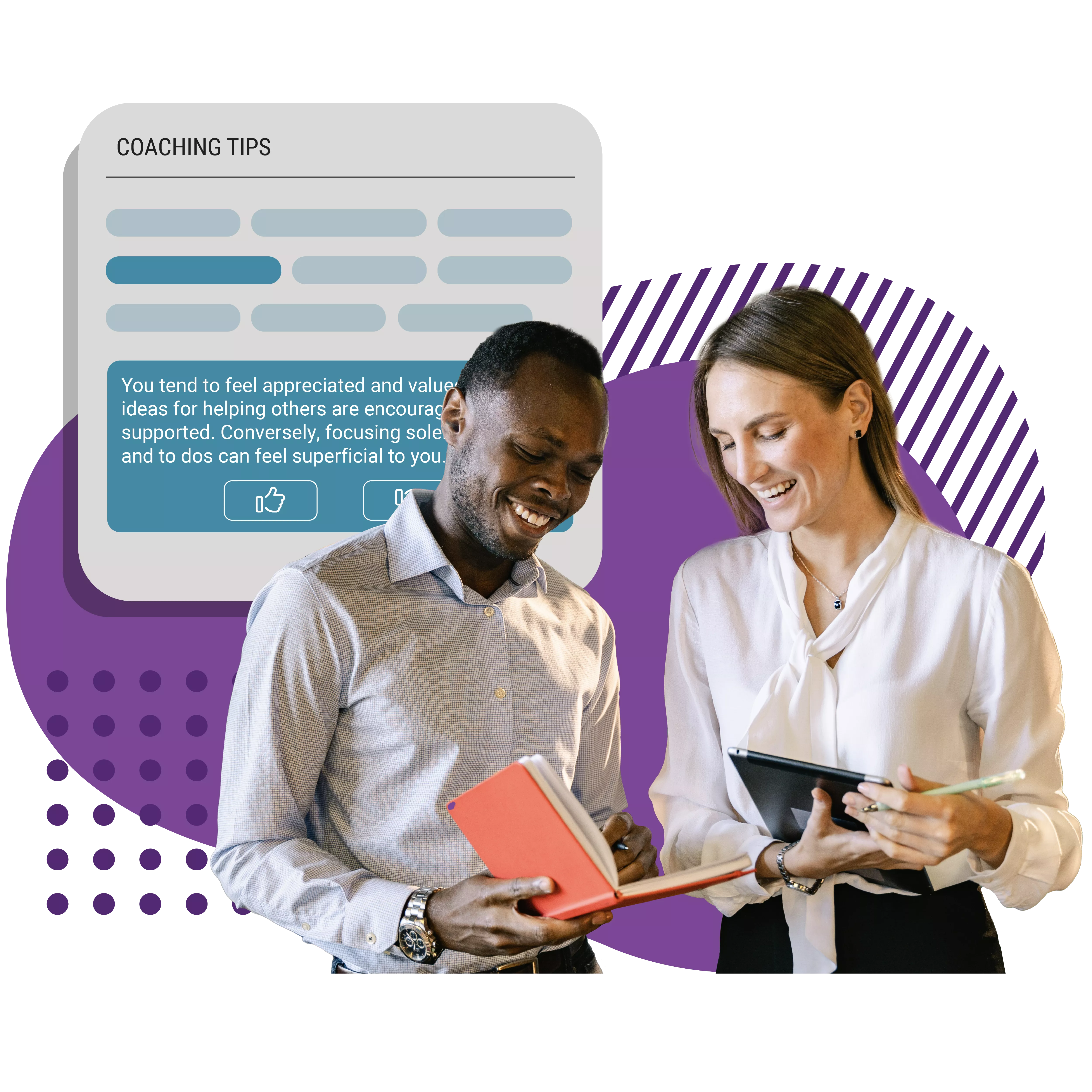
Transforming Leadership Coaching with Automated Coaching™
Leadership coaching can be more dynamic, responsive, and integrated into the daily life of organizations. By leveraging technology for personalization, accessibility, and scalability, Automated Coaching™ is poised to become the cornerstone of employee development strategies, ensuring that organizations remain agile and employees continuously grow.
Final Thoughts
It’s clear that this approach is more than just a management style—it’s a transformative style that can reshape the landscape of any organization. Here’s a summary of the key takeaways and some final thoughts on the enduring impact of coaching leadership.
Key Takeaways:
- Adaptability of Coaching Leadership: Coaching is not a static set of behaviors but a dynamic interplay of skills that adapt to the needs of individuals and the organization.
- Personal Growth and Team Development: At its core, coaching fosters personal growth, which catalyzes team development and organizational success.
- Cultural Shift: Implementing a coaching leadership style signifies a cultural shift towards a more collaborative, empathetic, and fulfilling workplace.
- Technological Integration: The future of coaching leadership is intertwined with technology, offering personalized, accessible, and scalable development opportunities through Automated Coaching™ for entire teams.
- Feedback-Rich Environment: A coaching culture thrives on communication skills, continuous feedback, shared learning, and a commitment to collective improvement.
Further Development and Resources:
For leaders looking to develop their coaching skills further, the following resources provide valuable insights and practical strategies for developing and cultivating a coaching culture within your organization:
These resources are designed to guide leaders through the nuances of coaching in the workplace, offering actionable advice on integrating coaching principles into their leadership approach and creating an environment where coaching is a natural part of the organizational fabric.
In conclusion, embracing coaching leadership is not just about adopting a new set of practices; it’s about nurturing a philosophy that values human potential and collective success. As organizations continue to evolve, the principles of coaching leadership will remain steadfast, guiding the way to a future where every leader is a coach and every interaction is an opportunity for growth and development.
Have you ever felt the weight of navigating through a workplace that seems rigid, unresponsive, or even impersonal? Contrast this with an environment where trust, collaboration, and genuine conversations are the norm. That’s the magic of a coaching culture—a transformative approach that is revolutionizing how we work and interact.
KEY TAKEAWAYS
- The Essence of a Coaching Culture: At its core, coaching emphasizes trust, collaboration, and accountability to promote open, growth-oriented conversations.
- Benefits Extend Beyond the Organization: Creating a coaching culture can enhance business outcomes, reduce turnover, and strengthen psychological safety.
- Feedback as a Dual-Growth Tool: Feedback serves as a powerful tool for mutual growth, benefiting both the giver and the receiver.
- Consistency in Application: For success, coaching must be consistently applied across all levels and interactions within the organization.

Defining a Coaching Culture in the Modern Workplace
At its core, a coaching culture embodies trust, accountability, and collaboration. Unlike traditional top-down management systems, where leaders dictate terms, a strong coaching culture promotes a paradigm where leaders act as facilitators. Leaders are more akin to guiding mentors or thinking partners, encouraging open dialogue, fostering individual growth, and cultivating team synergy. The emphasis shifts from focusing solely on results to nurturing personal and professional development, ensuring everyone feels valued and heard.
Allow me to share a personal story that demonstrates the impact of internal coaching in my professional life. Recently, I found myself under new leadership. This leader and I were poles apart in our approaches and personalities.
Over several months, we endeavored to understand each other, but the journey was challenging. It’s no secret that experiencing difficulty with a superior is not unique; many of my peers relayed similar struggles with their bosses—leaders who seemed unaware of their impact, disinterested in the development of their team, and lacked the compassion or intent to build personal relationships with members of their team.
Imagine spending most of your waking hours at work, only to feel invalidated or undermined consistently. The sense that your value to your team is perpetually overlooked can be disheartening. When I shared my frustrations with colleagues, the resonance was palpable. Some confided in their daily tears, while others considered leaving due to their unsupportive bosses. Another colleague hoped for a leadership change in the upcoming months.
Taking the initiative, I approached my leader to address these concerns. While many had done the same, my leader chose to engage in an open dialogue with me—a conversation of vulnerability.
This coaching approach proved to be a turning point. I presented my experiences, framing them as observational data. My feelings, arising from specific situations, led me to certain assumptions or, as some might call them, “learnings.” However, there was a lingering doubt: were my interpretations accurate? For instance, based on particular interactions, I questioned my perceived value within the team. Bringing these concerns forward, I was met with surprising feedback. My leader’s narrative differed starkly from my perceptions, offering a fresh perspective.
Interestingly, of the several such experiences I knew of—three of which involved my friends in similar job settings—only one leader (mine) chose to participate in such a dialogue. This highlights the rarity, yet importance, of open communication in a coaching culture.
A recent survey by my organization, LHH, showed that while 69% of all managers believe it is important for companies to provide coaching and mentoring on leadership skills, only 23% of leaders have received or are receiving coaching or mentoring. – forbes.com
Rather than being confrontational, our interactions were rooted in mutual respect and a genuine quest for understanding. During a particularly vulnerable conversation, where I shared my apprehensions and assumptions, we experienced a breakthrough.

HUMAN SKILL PROGRAMS ARE HITTING LIMITATIONS...
5 THINGS THIS FREE RESOURCE WILL TEACH YOU
- Close the widening gap between learning and on-the-job application
- Overcome the tension of pausing productivity for development opportunities
- Integrate learning so it is actually in the flow of work
- The evolution of human skill development
- What Automated Coaching™ is and how it works.

The Imperative for Change: What Is The Value Of Coaching?
A coaching mindset seeks to foster trust, accountability, and collaboration. Coaching conversations are not about merely directing. A coaching experience is rooted in creating a space where every member feels valued and validated.
Emotional intelligence and psychological safety have emerged as crucial components in today’s work environment, with the latter becoming the number one indicator of a team’s success. This safety and the intrinsic trust it fosters are pivotal for high-performing teams and creating a sense of belonging in the workplace.
When teams embed a coaching culture, they tend to achieve more tremendous success. Their performance often becomes the benchmark for others in the organization. Shifting the company culture is not about a sweeping organizational change right from the get-go; individual teams can embrace and champion this culture, setting an example for others.
The advantages of this culture extend beyond team dynamics. Coaching in the workplace can catalyze the connection between personal growth and broader business goals when considered on a larger scale.
The result? Enhanced stability and a significant reduction in turnover. In an age where employee engagement and retention are critical, employee coaching becomes even more necessary for supporting professional growth and leadership development.
6 Tangible Benefits Of Coaching for the Organization
- Personal Development: Coaching promotes individual growth, new skill development, and well-being.
- Impact on Business Outcomes: An individual’s progress and successes can intrinsically tie to the organization’s success.
- Foundation of Trust: Trust sits at the heart of culture, creating an environment of mutual respect and understanding.
- Reduction in Turnover: Trust also leads to reduced turnover. Employees feel valued, reducing the need for them to seek opportunities elsewhere.
- Alignment with Goals: Employees willingly align with the company’s goals and create action plans to develop relevant competencies.
- Increased Investment: Deeper investment and involvement from individuals can lead to high performance.
4 Strategies for Successful Implementation Building a Coaching Culture from the Ground Up
Establishing an effective coaching process isn’t instantaneous. It requires targeted strategies, unwavering stakeholder commitment, and proactive participation from everyone on the team.

1. Start Small: Practical Steps for Leaders and Teams
A. Engage Even in Difficult Environments
Leaders can lay the groundwork for change even in challenging organizations where tension is palpable. It may be tempting to assume that change can only come from a complete organizational shift, but small, calculated steps can make all the difference.
B. Harnessing the Power of Individual Teams
A pervasive misconception is that for coaching to be effective, it must start organization-wide. Individual teams can pioneer this culture, serving as examples for the broader organization. Test cultivating this culture at the micro-level to spread it throughout the company organically.
C. Utilize Simple Conversations
Often, the most profound changes start with straightforward, transparent dialogues. In the realm of coaching, it’s crucial to set clear expectations around conversations, ensuring both leaders and team members understand their roles and the goals of each interaction. This regularity in dialogue establishes a cadence, ensuring that feedback and coaching become normal.
2. Practice Two-Way Feedback For Dual Growth
In a coaching culture, feedback isn’t merely a tool; it’s the cornerstone. It provides opportunities for mentoring, clarity, and mutual understanding. But more importantly, it doesn’t just promote the growth of the one receiving the feedback; it’s a two-way street, and both leader and team member evolve together.
If leaders want their managers to take daily accountability for employee engagement, performance and development — to truly give up on bossing and begin real coaching — those managers need to be coached themselves. – gallup.com
A. Use Feedback as a Growth Mechanism
Feedback isn’t just about pointing out areas of improvement; it’s a bridge to understanding, collaboration, and mutual growth. However, embracing feedback isn’t always straightforward. It’s pretty vulnerable and may feel risky, especially when leaders aren’t accustomed to seeking it.
B. Dual Development
A misconception in traditional workplace hierarchies is that leaders coach and direct reports learn. However, this dynamic is turned on its head in a thriving coaching culture. Coaching isn’t a one-way spilling of knowledge or skills; it’s a collaborative journey. It’s a discovery process that two people or a team are doing together.
Feedback, when used effectively, does more than identify gaps; it fosters an environment of continuous improvement, mutual respect, and dual growth.
3. Navigate Challenges and Leverage Differences
Theory without practice is like a ship without a compass. Real-world experiences offer tangible evidence of the challenges and triumphs within a coaching culture.
A. Embracing Differences
Diversity is often celebrated for bringing various perspectives to the table, but it can also bring its fair share of challenges, especially when members have vastly different strengths and talents. However, these differences, when harnessed correctly, can be beneficial.
Consider my own experience; there is still ongoing learning between my leader and me, working through leveraging our different strengths. It’s not about seeing eye-to-eye on everything but appreciating and leveraging those unique qualities.
B. Confronting Challenges Head-On
Transitioning to a coaching culture may unearth hidden conflicts, but it’s also the best tool to navigate them. Don’t forget, when I got a new leader, it was not a seamless start to our relationship. There were misaligned expectations, which you don’t know until there’s some friction.
Introducing a new leader can be a challenge in any organization, especially if there are different perspectives or understandings. However, addressing these issues head-on can lead to resolution and mutual understanding.
C. Open Communication
When issues arise, the path to resolution often lies in dialogue, understanding, and mutual respect. Consider how my leader responded when I brought up my issue; he actually talked with me about what could go better and how we can move forward. This dialogue is essential in fostering understanding and creating a foundation for future collaboration.
It’s in our day-to-day real-life examples that it becomes evident that challenges are inevitable. However, a coaching approach can develop our know-how for navigating complex situations. Teams can thrive with open communication, a willingness to embrace differences, and confronting challenges head-on.
4. Addressing Core Challenges with Cloverleaf’s Automated Coaching
The road to embedding a coaching culture is not always without its hitches. Many teams and leaders grapple with specific pain points:
A. Catalyzing Genuine Behavioral Change:
Often, driving behavioral change can feel like scaling a steep mountain. The aspiration is clear: supporting individuals to become their best selves. Cloverleaf provides the dashboard and insights to navigate this challenge, turning aspirations into actionable coaching.
B. Navigating Impact Measurement:
Quantifying the effects of coaching and team development initiatives can leave people leaders guessing. Without tangible metrics, demonstrating the value of coaching to the broader business becomes nebulous. However, with Cloverleaf, you’re not just armed with data; you’re empowered with insights that resonate, showcasing the impact of your endeavors as pivotal to organizational success.
C. Equipping Managers for Diversity in Teams:
Leaders often find themselves at the helm of diverse teams, each member with unique strengths, motivations, and communication styles. Cloverleaf guides managers in understanding, valuing, and leveraging these diversities. The result? Teams that are not just effective but also harmonious.
With Cloverleaf, you can transform popular validated assessments into Automated Coaching™ for the whole team.
Your organization can:
A. Enhance Strength Awareness:
Cloverleaf’s team dashboard is more than just a digital interface. Members who engage with it experience significant improvements in teamwork quality. The platform fosters an environment where leaders and teammates:
- Recognize and capitalize on each other’s strengths.
- Adapt to evolving challenges and scenarios.
- Cultivate deeper collaboration and synergy.
B. Strengthen Recognition:
Everyone yearns for recognition and acknowledgment. Within just three months of utilizing the Cloverleaf platform:
- Individuals reported a 33% increase in feeling recognized.
- Members sensed a heightened appreciation for their unique skills and inputs, fostering a positive work environment and boosting morale.
C. Promote Psychological Safety:
A team’s success isn’t just about skills but also about how comfortable members feel expressing their opinions and ideas. Cloverleaf plays a pivotal role here by:
- Simplifying the intricacies of understanding varying personalities and behaviors within teams.
- Encouraging open dialogue and mutual respect.
Practical Application in Everyday Scenarios
Creating a culture of coaching doesn’t mean a complete overhaul of your existing workplace culture, hiring external coaches, or setting up formal coaching sessions every week. Instead, it’s about integrating intentional practices into daily interactions, one-on-ones, and workflows.

4 Characteristics Of A Coaching Culture
1. Practice Coaching In The Flow Of Work:
Incorporating coaching into the very fabric of daily work does more than enhance skills—it transforms mindsets. As individuals become more adept and versatile, they invigorate their teams, creating a positive domino effect that can resonate throughout the organization.
2. Foster Trust And Transparency:
A thriving culture is rooted deeply in trust and transparency. Coaching is more than just believing in someone’s expertise; it’s about fostering a shared belief that everyone is collectively working toward the organization’s success. By maintaining open communication channels, embracing feedback, and celebrating each person’s unique strengths, teams build trust and create a resilient bond that elevates results.
3. Move Beyond Transactional Interactions:
In a coaching culture, interactions are more than just transactional. Instead of merely giving instructions or feedback, there’s a focus on understanding, mutual respect, and learning. Every interaction is an opportunity for growth and understanding.
4. Develop Consistency:
For a coaching culture to be successful, it needs to be consistent. It can’t just be a one-off workshop, a once-a-year coach training, or limited to the C-suite. Instead, coaching principles must be embedded in daily interactions, whether it’s a team meeting, a one-on-one catch-up, or even a quick chat by the water cooler.
Final Thoughts
Establishing a coaching culture means moving away from a top-down approach to leadership and towards an environment where every person feels valued, understood, and empowered to contribute their best to the organization. And it all starts with trust. Without trust, the foundation is shaky, but with it, the possibilities for growth and success are limitless.
Effective coaching is a critical element for success in any modern workplace. Without employee coaching conversations, leaders can struggle to motivate individuals, achieve high-performance levels, or retain top talent. Leaders face numerous challenges, including managing team dynamics, ensuring productivity, and developing individual potential.
It’s no wonder that organizations invest in helping their leaders upskill to become good coaches. A coaching culture is critical to successful leadership and can improve employee engagement. Plus, leaders who coach can increase professional development, enhance productivity, better identify high-potential employees, and ultimately, drive organizational growth.
Whether you’re a seasoned leader or new to coaching, keep reading to find valuable insights and actionable strategies for improving your coaching competencies to achieve better outcomes for your organization.

What Is Employee Coaching?
Employee coaching is a structured process through which leaders empower individuals and teams to achieve their full potential by drawing out their knowledge and ideas. It involves asking questions, providing feedback, and offering support to help employees overcome challenges and achieve their goals. By developing a coaching relationship with team members, leaders serve as thinking partners rather than managers to assist employees in self-directing to reach desired outcomes.
Coaching isn’t supposed to be used for everything. If someone asks where to find a specific file or spreadsheet – tell them! But when employees come to leaders with challenges to solve or goals to set, it is tempting to go into advising, training, or mentoring rather than coaching.
While coaching in the workplace isn’t a new idea, leaders and organizations still struggle to articulate what it is and how to empower their leaders to do it. As a result, some leaders may struggle to transition from the traditional “Boss” role to a more collaborative and empowering “Coach” role. (We even wrote a whole playbook about it here!).
Leaders who adopt a coaching approach can tap into the knowledge and ideas of their employees rather than simply directing them from a position of authority. Effective employee coaching operates from the belief that individuals are competent and resourceful, with leaders serving as facilitators rather than directors. This approach allows leaders to guide and support their employees’ development, leverage their existing skill sets, and enhance their problem-solving capabilities.
Real-World Examples of How Leaders Can Coach Employees
Imagine an employee approaches their leader with the desire to work towards a leadership position. In one scenario, the leader offers advice based on their own experience and suggests a book and a course in leadership. While nothing is inherently wrong with this approach, it may not be the most effective way to develop the employee.
In contrast, in a coaching scenario, the leader focuses on employee development by helping the individual to recognize their strengths and areas for growth, then offers support and guidance to help them create an action plan.

A Coaching In The Workplace Scenario
Scenario: An employee approaches their leader to express their ambition to grow into a leadership role within the organization.
Directive Management:
Leader: This sounds great. This reminds me of when I was first exploring leadership. I read this book that made all the difference and helped me to become the leader I am today. You should also check out a course in leadership to help you develop your communication skills.
Let’s stop this interaction here. Is there anything wrong with it? No. However, it’s more focused on the leader rather than the employee. It’s not horrible to share for the leader to share their favorite leadership book. Still, successful coaching takes the focus off of oneself to help reveal what’s driving the individual and support the employee’s progress.
Effective Workplace Coaching
Leader: This sounds like a good goal for you. What strengths do you want to leverage in a leadership role?
Employee: Well, I know that I like to problem solve like I did last week as we were approaching that deadline; I think I can use that skill, especially in our department.
Leader: That was extremely helpful when you helped us stay on track last week. I can see that as an asset for our department. What areas do you need the most support in when taking on a leadership role?
Employee: Well, I am pretty conflict avoidant. I tend to people please or shy away from having difficult conversations. I know I will need support here.
Leader: I think that’s a great area to focus on developing. How can I support you in developing that skill?
Do you recognize the difference? Employee coaching is about leveraging and developing the existing talent and ability of the person in the moment. A coaching process requires asking questions, providing constructive feedback, and offering support.
During coaching sessions, leaders may make assumptions and treat them as valid without confirming their accuracy. Coaches can better understand their employees’ perspectives, experiences, and challenges by adopting a curious approach. This approach can unlock their full potential by tapping into their unique strengths and capabilities, allowing them to thrive individually and as a part of the broader team.

HUMAN SKILL PROGRAMS ARE HITTING LIMITATIONS...
5 THINGS THIS FREE RESOURCE WILL TEACH YOU
- Close the widening gap between learning and on-the-job application
- Overcome the tension of pausing productivity for development opportunities
- Integrate learning so it is actually in the flow of work
- The evolution of human skill development
- What Automated Coaching™ is and how it works.
Unlocking Employee Potential: Exploring the Key Benefits of Employee Coaching
According to Up Coach, coaching in the workplace can increase employee engagement (67%), improve employee perceptions of leadership quality (60%), strengthen leadership bench strength (54%), improve productivity (50%), and enhance the quality of work (44%).
And yes, at the end of the day, coaching can affect the bottom line. About 63% of organizations that provide employee coaching report higher revenue and income growth than their competitors.
If you must, you can google down a rabbit hole of how to measure the ROI of coaching and how it affects engagement, or you can trust your instinct here. (We also share about defining the goal of coaching moments and how to measure if it is successful HERE.)

When companies invest in coaching skill training for their leaders or external coaching to support employee development and well-being, it helps team members experience a healthy work environment and improves retention.
It’s no secret that engagement can result in organizational loyalty. A loyal team member who feels invested in by their employer will often invest back into the organization through effort, quality outputs, and longevity.
Why Access To Coaching Is Essential For Employees
Think of an employee as a vehicle. The more fuel it receives and the more cylinders it runs on, the farther it travels and faster. Coaching is not only the language of leadership; it’s the ultimate employee performance accelerator. It encourages employees to be proactive about setting goals and navigating challenges and keeps them thinking.
Coaching is also something that shows its value subtly and over time. It’s not an overnight benefit; it’s the repetition of receiving coaching that ultimately opens the employee up to new possibilities, new ways of thinking, and new goals to set.
Allowing team members to engage in their own thought processes and explore what makes them effective can make them more intentional in their actions and decision-making.
Effective Strategies For Coaching Employees In The Workplace
In traditional coaching models, providing every employee a one-on-one personal coach is typically impossible. Therefore, empowering leaders to use coaching skills through comprehensive training solutions is fantastic. However, even that might not always be realistic; this is where Cloverleaf makes the difference.
Through Automated Coaching™, using personally curated assessment data, Cloverleaf provides that extra cylinder of support to employees daily. Supporting individuals and teams to leverage strengths and identify gaps, Cloverleaf offers relevant insights into the flow of work that usually remain blindspots within an individual or team.
By increasing the frequency of coaching moments, organizations can empower employees and teams to work to their potential and contribute their best work… who doesn’t want that?
Final Thoughts
Coaching is vital for any modern workplace to motivate employees, improve performance levels, and retain top talent. It’s no wonder more organizations are investing in helping their leaders upskill to become good coaches. Coaching is not just the language of leadership; it’s the ultimate employee performance accelerator. With the right approach and tools, organizations can empower employees to work to their potential and contribute their best work.

